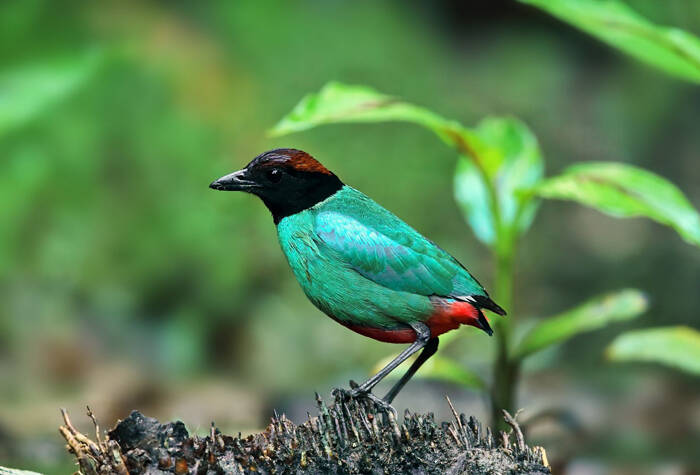Pitta sordida
IUCN
LCBasic Information
Scientific classification
- name:Pitta sordida
- Scientific Name:Pitta sordida,Hooded Pitta
- Outline:Songbird
- Family:Passeriformes Pittidae Pitt
Vital signs
- length:17-18cm
- Weight:65-69g
- lifetime:No verification information
Feature
Black head, green upper body, dark wings with white markings
Distribution and Habitat
Distributed in Bangladesh, Bhutan, Brunei Darussalam, Cambodia, China, India, Indonesia, Lao People's Democratic Republic, Malaysia, Myanmar, Nepal, Papua New Guinea, Philippines, Singapore, Thailand, Vietnam.
Migrant bird: Japan.
The Green-breasted Pitta mainly inhabits tropical rainforests or monsoon forests at an altitude of 700-1300 meters, and is often seen foraging in the shade and wet places under the forest and by the water. Especially in sparse forests, shrubs, secondary forests and small trees, and sometimes also appears in the woods and shrubs near the village.
Appearance
The green-breasted thrush is bright chestnut brown from the forehead to the back occiput, with a hint of black on the forehead; the eyes, narrow eyebrow lines, eye circles, cheeks, ear feathers, chin, throat and neck are all black, and the back of the neck is especially black. Bright. The surface of the back, shoulder feathers and flight feathers is bright oily green, and the primary flight feathers have large white wing spots. The chest, abdomen and flanks are light grass green with blue rendering, which is obviously different from the blue-winged thrush and Malay thrush. The feathers from the center of the abdomen to the lower part of the tail are scarlet, and the feathers in the center of the upper abdomen are black. The plumage color of the female bird is similar to that of the male bird. The iris is dark brown; the mouth is black or dark brown; the feet are brownish gray.
Size measurement: weight 65-69 grams; body length 172-182 mm; mouth peak 22-23 mm; wings 109-110 mm; tail 3
Details
The green-breasted pitta is called Hooded Pitta in English, and has 12 subspecies.

The green-breasted pitta is mostly seen alone, and sometimes 2~3 are seen together. It often digs up fallen leaves in wet leaf houses, frequently turning over dead branches and leaves on the ground with its feet to find food. It feeds on insects of the Coleoptera family and the family of Curculionidae, larvae of the Lepidoptera, ants of the Hymenoptera, earthworms, termites, as well as seeds and fruits and other animal foods. It repeats the double whistle sound "pih-pih" with very short intervals.
The Green-breasted Pitta breeds in tropical rainforests below 1,500 meters above sea level. The breeding season is from May to July. It usually nests on the ground or in a pile of branches. The nests it builds are relatively rough, mainly made of twigs, bamboo leaves, leaves, twigs, dead grass, moss, lichens, grass stems and roots. The nest entrance is mostly opened near the ground, and there are usually many hidden objects such as fallen leaves or other debris to bury the nest. In areas dominated by bamboo, bamboo leaves account for a large proportion of the main building materials for nest construction. Each nest contains 3 to 6 eggs, with colors ranging from light red, dark purple or white. The size of the eggs is 28 to 23 mm × 22.5 to 19.6 mm, with an average of 27 mm × 21 mm. The male and female build the nest, incubate and feed the chicks together. The incubation lasts about 17 days.
Listed in the 2013 Red List of Endangered Species of the World Conservation Union (IUCN) ver 3.1 - Least Concern (LC).
Listed in the second level of the List of National Key Protected Wildlife in China.
Protect wildlife and eliminate game.
Maintaining ecological balance is everyone's responsibility!








